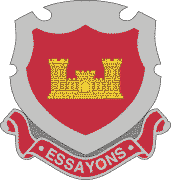U. S. Army Corps of Engineers
| U.S. Army Corps of Engineers | |
|---|---|

|
|
| Active | 11 June 1775 – present |
| Country |
|
| Branch |
|
| Size | 37,000 civilian and military (approx. 2%) members |
| Garrison/HQ | Washington, D.C., U.S. |
| Motto(s) | Essayons (Let Us Try) |
| Colors | Scarlet and White |
| Website | www.USACE.Army.mil |
| Commanders | |
| Current commander |
Lieutenant General Todd T. Semonite, Chief of Engineers |
| Notable commanders |
COL Richard Gridley, BG Louis Lebègue Duportail, COL Joseph Swift, COL Alexander Macomb, Jr., BG William Louis Marshall, MG Richard Delafield, BG Joseph Totten, BG Henry Robert, LTG Edgar Jadwin, LTG Leif J. Sverdrup |
| Insignia | |
| Shoulder Sleeve Insignia |  |
| Branch Insignia |  |
| Regimental Insignia |  |
The United States Army Corps of Engineers (USACE) is a U.S. federal agency under the Department of Defense and a major Army command made up of some 37,000 civilian and military personnel, making it one of the world's largest public engineering, design, and construction management agencies. Although generally associated with dams, canals and flood protection in the United States, USACE is involved in a wide range of public works throughout the world. The Corps of Engineers provides outdoor recreation opportunities to the public, and provides 24% of U.S. hydropower capacity.
The corps' mission is to "Deliver vital public and military engineering services; partnering in peace and war to strengthen our Nation's security, energize the economy and reduce risks from disasters."
Their most visible missions include:
The history of United States Army Corps of Engineers can be traced back to 16 June 1775, when the Continental Congress organized an army with a chief engineer and two assistants.Colonel Richard Gridley became General George Washington's first chief engineer. One of his first tasks was to build fortifications near Boston at Bunker Hill. The Continental Congress recognized the need for engineers trained in military fortifications and asked the government of King Louis XVI of France for assistance. Many of the early engineers in the Continental Army were former French officers. Louis Lebègue Duportail, a lieutenant colonel in the French Royal Corps of Engineers, was secretly sent to America in March 1777 to serve in Washington's Continental Army. In July 1777 he was appointed colonel and commander of all engineers in the Continental Army, and in November 17, 1777, he was promoted to brigadier general. When the Continental Congress created a separate Corps of Engineers in May 1779 Duportail was designated as its commander. In late 1781 he directed the construction of the allied U.S.-French siege works at the Battle of Yorktown. From 1794 to 1802 the engineers were combined with the artillery as the Corps of Artillerists and Engineers.
...
Wikipedia
